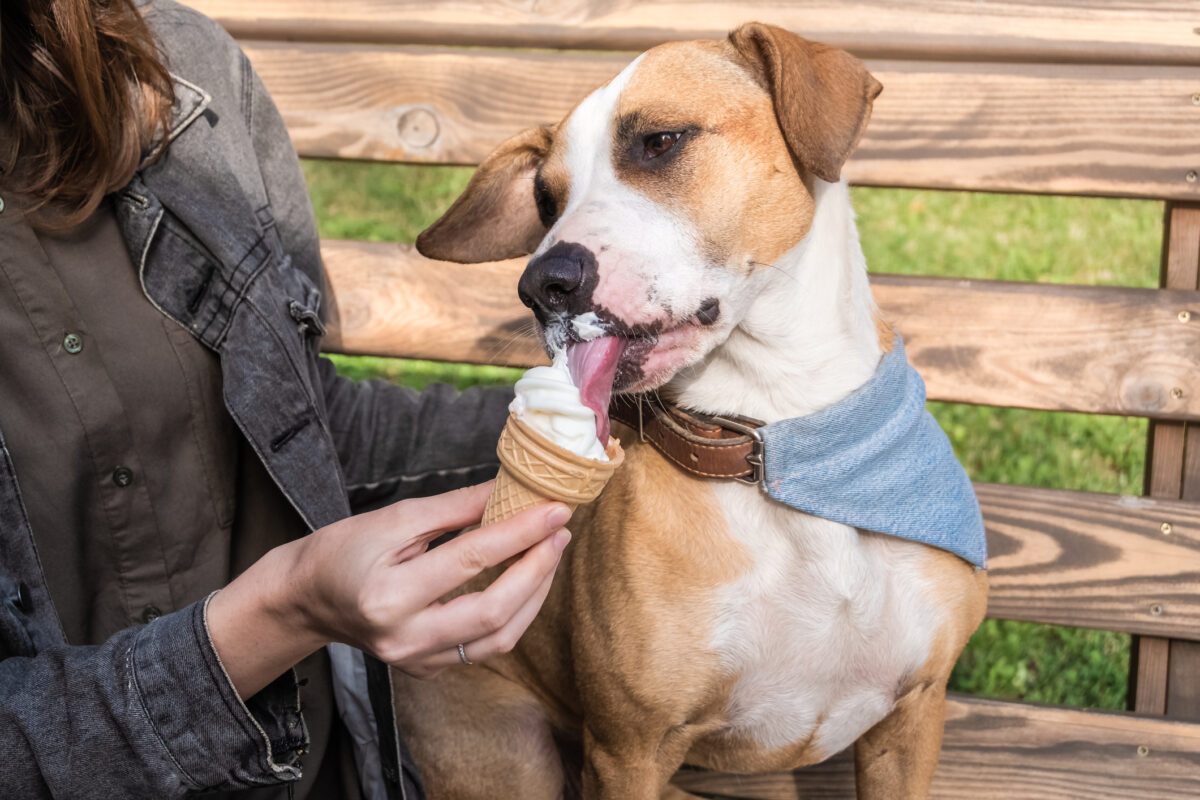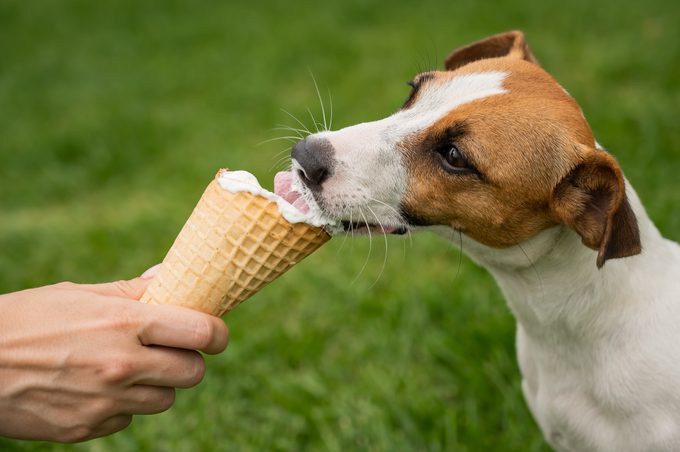Is all that tableside begging making you wonder, Can dogs eat ice cream? Here's everything you should know before sharing your next scoop.

Can Dogs Eat Ice Cream? What Pet Owners Need to Know

It’s hard to say who loves ice cream more: humans or dogs. While we devour our cone, they sit nearby, willing a scoop to tumble their way. “Dogs love ice cream for all the reasons we do,” says veterinarian Sam Meisler, DVM, founder and CEO of PetWellClinic. “It is high in sugar, fat and even salt. All those ingredients make it very palatable.” Translation: It tastes delicious! But can dogs eat ice cream?
As pet parents, we know there are certain human foods that are good for dogs—like sweet potatoes and eggs—and also foods they can’t eat, like grapes and mushrooms. So where does ice cream stand in the dog diet? Are any types safe? We asked Dr. Meisler and veterinarian Heather Berst, DVM, a medical lead with Zoetis, a global animal health company, to give us the scoop. Read on for the details that will ensure your dog stays healthy.
Get Reader’s Digest’s Read Up newsletter for more pets, humor, cleaning, travel, tech and fun facts all week long.
Can dogs eat ice cream?
A dog can eat some ice cream flavors in small amounts, says Dr. Meisler, but this treat “can be fraught with potentially harmful effects—and even death.” Yikes. Ice cream may not seem harmful, but it can be poisonous to dogs, depending on its ingredients. Raisins and chocolate are super dangerous for your furry friend, for example. Artificial sweeteners can also be a big no-no. (More on that below.)
Is it safe for dogs to eat plain vanilla ice cream?
Dangerous ingredients aside, you might be wondering, Can dogs eat vanilla ice cream? After all, what’s the harm in plain ol’ vanilla? Well, even though milk is a healthy food for most humans, dogs generally don’t tolerate dairy products well. A few licks won’t harm them, but more can make them mighty uncomfortable.
“Most dogs do not have the enzymes necessary to digest lactose,” explains Dr. Meisler. Enzymes are critical for many metabolic functions, and without the enzymes needed to break down dairy, your pup could have a rumbly, painful tummy ache—or worse—after eating ice cream.
How much ice cream can a dog safely eat?
It’s most likely OK if your pup sneaks a few licks from a bowl of basic vanilla as you’re loading the dishwasher, but they shouldn’t have more than that. “Some dogs can tolerate dairy better than others, but you are taking a risk if you give them ice cream for the first time,” says Dr. Berst.
It can be hard to resist those adorable puppy-dog eyes staring at you while you eat spoon after spoon of your favorite ice cream, but hold firm and toss them a healthy dog treat instead. Just don’t go overboard: “Treats should account for 10% or less of a dog’s daily caloric intake,” says Dr. Berst.
Can dogs eat dairy-free ice cream?
A dairy-free option might not cause tummy trouble, but you have to consider its other ingredients, which could potentially be much more dangerous. “Chocolate, as in dark chocolate chips, depending on the amount given and the weight of the dog, can be fatally toxic to dogs,” says Dr. Meisler. A dairy-free flavor might also contain artificial sweeteners, which can be toxic to dogs.
What are the health risks of giving ice cream to dogs?

There are a number of health and safety concerns when it comes to dogs eating ice cream. They range from tummy troubles to life-threatening situations, so it’s key to know them all.
Upset stomach and weight gain
When a pooch gobbles up ice cream, they will most likely experience an upset stomach, cramping, gas, bloating, vomiting and/or diarrhea. The problem is that some of these warning signs of doggy pain aren’t obvious, so we might think they’re digesting the frozen treat just fine. And, of course, our dogs can’t connect the dots that yummy ice cream equals an upset tummy, so the cycle repeats. “The eventual outcome may end up being an uncomfortable dog that is gaining excess weight,” says Dr. Meisler.
Food allergies
Though food allergies aren’t as common in dogs as airborne allergies, some of the most popular dog breeds, such as the Labrador retriever and cocker spaniel, may have an increased risk of developing them. Common culprits are chicken, beef, corn, wheat and eggs, as well as milk and soy—two standard ingredients in dairy and nondairy ice cream, respectively. Signs of food allergies in dogs include itching, swelling and reddening of the skin.
Pancreatitis
In extreme cases, dogs that eat ice cream could get a very serious disease called pancreatitis, which may require hospitalization to treat, says Dr. Berst. Typically, this condition happens after introducing a rich new food or treat (like ice cream). Normally, the pancreas shoots enzymes into the gut to help with digestion, and it also regulates glucose and insulin in the body. But in pancreatitis, the pancreas becomes inflamed, which leads to damage in other parts of the body. The standard symptoms are loss of appetite, weakness, vomiting, fever, diarrhea, stomach pain and dehydration.
What other ice cream ingredients should you watch out for?
Dogs are opportunistic by nature and would love to get their paws on virtually any flavor of ice cream, but some ingredients could cause food poisoning in dogs. “There are a lot of common ice cream ingredients that can cause problems for a dog, including chocolate, raisins, macadamia nuts, walnuts, coffee and xylitol,” says Dr. Berst. These are ones to steer clear of:
Chocolate, raisins and macadamia nuts
The raisins in rum raisin ice cream contain an unknown substance that is toxic to dogs and can cause kidney damage. Chocolate contains a chemical called theobromine, as well as caffeine—both of which are poisonous to dogs.
Dogs metabolize these ingredients much more slowly than we do, which can cause a host of problems. Symptoms you might notice right away are vomiting and diarrhea. If your dog wolfed down a lot of ice cream, they could have more severe symptoms, such as excess urination, muscle tremors, seizures and cardiac arrhythmias; this could even lead to death.
Any ice cream with macadamia nuts is potentially toxic too. Scientists haven’t nailed down why, but they do know macadamia nuts can cause a variety of canine health problems, including weakness, vomiting, tremors, hyperthermia and poor muscle control.
Artificial sweeteners
Xylitol—one of the most widely used artificial sweeteners—is found in sugar-free varieties of peanut butter, baked goods, candy and, yes, ice cream. Humans can generally eat it without an issue, but even very small quantities of xylitol can be fatal to dogs, Dr. Meisler warns. When dogs eat xylitol, it is quickly absorbed into their bloodstream and may prompt a rapid release of insulin from the pancreas, which can result in dangerously low blood glucose levels (hypoglycemia). This can become life-threatening if not treated quickly. Early signs include vomiting, but as hypoglycemia quickly progresses, it can lead to muscle weakness, lethargy, seizures and collapse.
What about other sweeteners? Can dogs eat ice cream that has aspartame, sucralose or stevia? While these ingredients aren’t toxic, they can cause gastrointestinal discomfort and diarrhea, so your pup should avoid them.
What should I do if my dog eats ice cream?
If you leave a bowl of ice cream unattended and your dog devours the whole thing, you need to act fast—especially if they got into a flavor with chocolate or other bad-news ingredients. “First and foremost, call your veterinarian if you have any questions about an ingredient your dog ate, and do not wait to call,” says Dr. Berst. “Your veterinarian will be able to guide you about what to do and if your dog needs to come in for treatment.” If you can’t get through to your vet, call ASPCA’s Animal Poison Control or the Pet Poison Helpline.
What are safe alternatives to ice cream for dogs?
You can still treat your pupster to the sweet delights of ice cream—just make it a doggy-friendly scoop. Many grocery stores and pet shops carry soy or other nondairy-based ice cream options specifically made for dogs. You might also be able to find nondairy-based people ice cream that doesn’t contain xylitol or other offenders like chocolate and nuts. “You can try ice cream that uses nonfat Greek yogurt or kefir as a base to avoid the higher fat and sugar content in traditional ice cream,” says Dr. Berst.
You could also whip up a batch pup-safe ice cream at home. It’s easier than you think!
Homemade frozen treats for your dog
- Blend 32 ounces of plain fat-free Greek yogurt or kefir with two ripe bananas.
- Line a 9-by-9-inch baking dish with parchment paper, and spread the yogurt mixture evenly.
- Freeze until firm.
- Cut into bite-sized pieces.
Your dog might dig these treats cold, but you can also thaw them out for a creamier ice cream–like texture. According to Dr. Berst, you can swap the bananas for 2 tablespoons of peanut butter too. Or sub in or add blueberries, apples (without the seeds and core), watermelon, pumpkin and just about anything nontoxic your dog goes wild for.
About the experts
|
Why trust us
At Reader’s Digest, we’re committed to producing high-quality content by writers with expertise and experience in their field in consultation with relevant, qualified experts. We rely on reputable primary sources, including government and professional organizations and academic institutions as well as our writers’ personal experiences where appropriate. For this piece on whether dogs can eat ice cream, Lisa Marie Conklin tapped her experience as an animal lover specializing in pet content for Reader’s Digest. We verify all facts and data, back them with credible sourcing and revisit them over time to ensure they remain accurate and up to date. Read more about our team, our contributors and our editorial policies.
Sources:
- Sam Meisler, DVM, founder and CEO of PetWellClinic, a chain of walk-in pet-wellness clinics
- Heather Berst, DVM, veterinarian and medical lead with Zoetis, a global animal health company
- Merck Veterinary Manual: “Nutritional Requirements of Small Animals”
- Merck Veterinary Manual: “Allergies in Dogs”
- U.S. Food and Drug Administration: “Paws Off Xylitol; It’s Dangerous for Dogs”
- Merck Veterinary Manual: “Xylitol toxicosis in dogs”
- Merck Veterinary Manual: “Pancreatitis and Other Disorders of the Pancreas in Dogs”



















